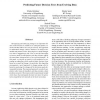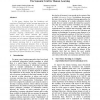16160 search results - page 145 / 3232 » How to approach humans |
CVPR
2012
IEEE
11 years 10 months ago
2012
IEEE
Attributes are visual concepts that can be detected by machines, understood by humans, and shared across categories. They are particularly useful for fine-grained domains where c...
ICCV
2007
IEEE
14 years 10 months ago
2007
IEEE
Local part-based human detectors are capable of handling partial occlusions efficiently and modeling shape articulations flexibly, while global shape template-based human detector...
ICDM
2008
IEEE
14 years 2 months ago
2008
IEEE
Recognizing and analyzing change is an important human virtue because it enables us to anticipate future scenarios and thus allows us to act pro-actively. One approach to understa...
ACMDIS
1997
ACM
14 years 14 days ago
1997
ACM
Human-computer interaction is multidisciplinary, drawing paradigms and techniques from both the natural sciences and the design disciplines. HCI cannot be considered a pure natura...
CCGRID
2005
IEEE
14 years 1 months ago
2005
IEEE
In this paper, starting from the limitations and constrains of traditional human learning approaches, we outline new suitable approaches to education and training in future knowle...


